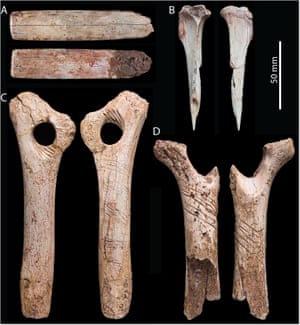via Boing Boing by Andrea James
Spanish designer Alberto Lucas López created this gorgeous infographic that shows the proportion of native speakers of each major language.
Continue reading
You really do need to see the infographic for yourself. At full size it is simply stupendous.
=============================
via the Guardian by Hannah Devlin, Science correspondent

The researchers suggest the engravings may have been part of an elaborate post-death ritual carried that culminated in the deceased being eaten. Photograph: Bello et al (2017)
Engraved bones unearthed in a Somerset cave have revealed new evidence of macabre cannibalistic rituals carried out by early humans in Britain.
The latest analysis of the bones, which were first discovered in the 1980s in Gough’s Cave in the Cheddar Gorge, show signs of having been filleted using sophisticated butchery techniques, decorated and gnawed by fellow humans around 15,000 years ago.
Previous investigations of the remains, belonging to a three-year-old child, two adolescents and at least two adults, already pointed to the grisly possibility that the individuals had been eaten by fellow early modern humans.
Continue reading
=============================
via Boing Boing by Mark Frauenfelder

Here’s a good puzzle from Martin Gardner's Mathematical Circus. The book is out of print but used copies are cheap.
Problems involving weights and balance scales have been popular during the past few decades. Here is an unusual one invented by Paul Curry, who is well known in conjuring circles as an amateur magician
You have six weights. One pair is red, one pair white, one pair blue. In each pair one weight is a trifle heavier than the other but otherwise appears to be exactly like its mate. The three heavier weights (one of each color) all weigh the same. This is also true of the three lighter weights. In two separate weighings on a balance scale, how can you identify which is the heavier weight of each pair?
=============================
via 3 Quarks Daily: Edward Lucas in More Intelligent Life
Some cities you go to for the galleries, some for the restaurants, some for the nightlife. You visit Venice to stroll through the alleys, bridges and squares that make up the most beautiful public space in the world. The walk that is richest in architectural delights and historical significance follows the route from the Rialto Bridge to St Mark’s Square. The bridge was the hub of the trading empire that brought in the booty and paid for the city’s unique concentration of artistic masterpieces. The merchants of Venice hung around the bridge for information on promising deals and lost cargoes. “What news on the Rialto?” asks Shylock.
Wiggle eastwards from the business district of the ancient city through the narrow passageways and sotoporteghi (alleys that pass through buildings) and you emerge through the great arch at the base of the 15th-century clock tower and into Venice’s political and religious heart – St Mark’s Square. The walk is a little more than half a mile, and shouldn’t take you longer than ten minutes. It will, though. Much longer. For during the warm months of the year the route is jammed with a slow-moving flotilla of tourists. Many are oblivious to those around them, having tuned out to listen to their guide through their headsets. You become wedged, unable to go forwards or back.
Continue reading
=============================
via the Guardian by Nicola Davis

View of the A68 iceberg on the 30 July 2017, taken from a European Copernicus Sentinel-1 satellite image. Photograph: A. Fleming, British Antarctic Survey.
Scientists have revealed exactly how the trillion-tonne A68 iceberg broke free of the Antarctic ice shelf last month – and say it has spawned smaller icebergs
The fate of the giant iceberg that broke free from Antarctica’s Larsen C ice shelf last month has been revealed.
Twice the size of Luxembourg, the trillion-tonne iceberg known as A68 was found to have broken off the ice shelf on 12 July after months of speculation about a rift which had been growing for years, with the iceberg “hanging by a thread” for weeks.
Continue reading
=============================
via 3 Quarks Daily by Ashutosh Jogalekar
The Nobel Prize winning animal behaviorist Konrad Lorenz once said about philosophers and scientists, “Philosophers are people who know less and less about more and more until they know nothing about everything. Scientists are people who know more and more about less and less until they know everything about nothing”. Lorenz had good reason to say this since he worked in both science and philosophy. Along with two others, he remains the only zoologist to win the Nobel Prize for Physiology or Medicine. His major work was in investigating aggression in animals, work that was found to be strikingly applicable to human behavior. But Lorenz’s quote can also said to be an indictment of both philosophy and science. Philosophers are the ultimate generalists, scientists are the ultimate specialists.
Continue reading
I found this fascinating. I wonder if you will.
=============================
via Boing Boing by Andrea James

Josh Jones at Open Culture looks at the Speyer wine bottle, the oldest (and possibly grossest) unopened bottle of wine.
I'm no sommelier, but it looks as if it turned.
Continue reading
=============================
via Interesting Literature
A summary of Shakespeare’s 53rd sonnet
‘What is your substance, whereof are you made, / That millions of strange shadows on you tend?’ Sonnet 53 is pored over and analysed by Cyril Graham in Oscar Wilde’s brilliant short story ‘The Portrait of Mr W. H.’ (1889), about a man who thinks he’s discovered the identity of the mysterious dedicatee of the 1609 edition of Shakespeare’s Sonnets. Believing ‘Mr W. H.’ to be a boy-actor named Willie Hughes, Wilde’s protagonist cites this sonnet as part of his internal evidence: the ‘strange shadows’ are the various roles played by the actor on the Elizabethan stage. Unfortunately, there’s no evidence such an actor as Willie Hughes ever existed. Nevertheless, this makes Sonnet 53 immediately interesting – but as closer analysis reveals, we don’t need any high-flown theories or interpretations to find this sonnet of interest.
Continue reading
=============================
via OUP Blog by Brad Kent

“George Bernard Shaw near St Neots from the Millership collection” from the Birmingham Museums Trust, CC BY-SA 4.0 viaWikimedia Commons.
In times of populism, soundbites, and policy-by-Twitter such as we live in today, the first victims to suffer the slings and arrows of the demagogues are intellectuals. These people have been demonised for prioritising the very thing that defines them: the intellect, or finely reasoned and sound argument. As we celebrate the 161st birthday of Bernard Shaw, one of the most gifted, influential, and well-known intellectuals to have lived, we might use the occasion to reassess the value of intellectuals to a healthy society and why those in power see them as such threats.
Continue reading
=============================
via Library Link: Richard Gray in The Atlantic

Two photos of the same pages from an ancient manuscript. The left is a normal image. The right is a special composite image that illuminates underlying erased words.
For centuries they have gathered dust on the shelves of a library marooned in a rocky patch of Egyptian desert, their secrets lost in time. But now a collection of enigmatic manuscripts, carefully stored behind the walls of a 1,500-year-old monastery on the Sinai Peninsula, are giving up their treasures.
The library at Saint Catherine’s Monastery is the oldest continually operating library in the world. Among its thousands of ancient parchments are at least 160 palimpsests – manuscripts that bear faint scratches and flecks of ink beneath more recent writing. These illegible marks are the only clues to words that were scraped away by the monastery’s monks between the 8th and 12th centuries to reuse the parchments. Some were written in long-lost languages that have almost entirely vanished from the historical record.
Continue reading
No comments:
Post a Comment